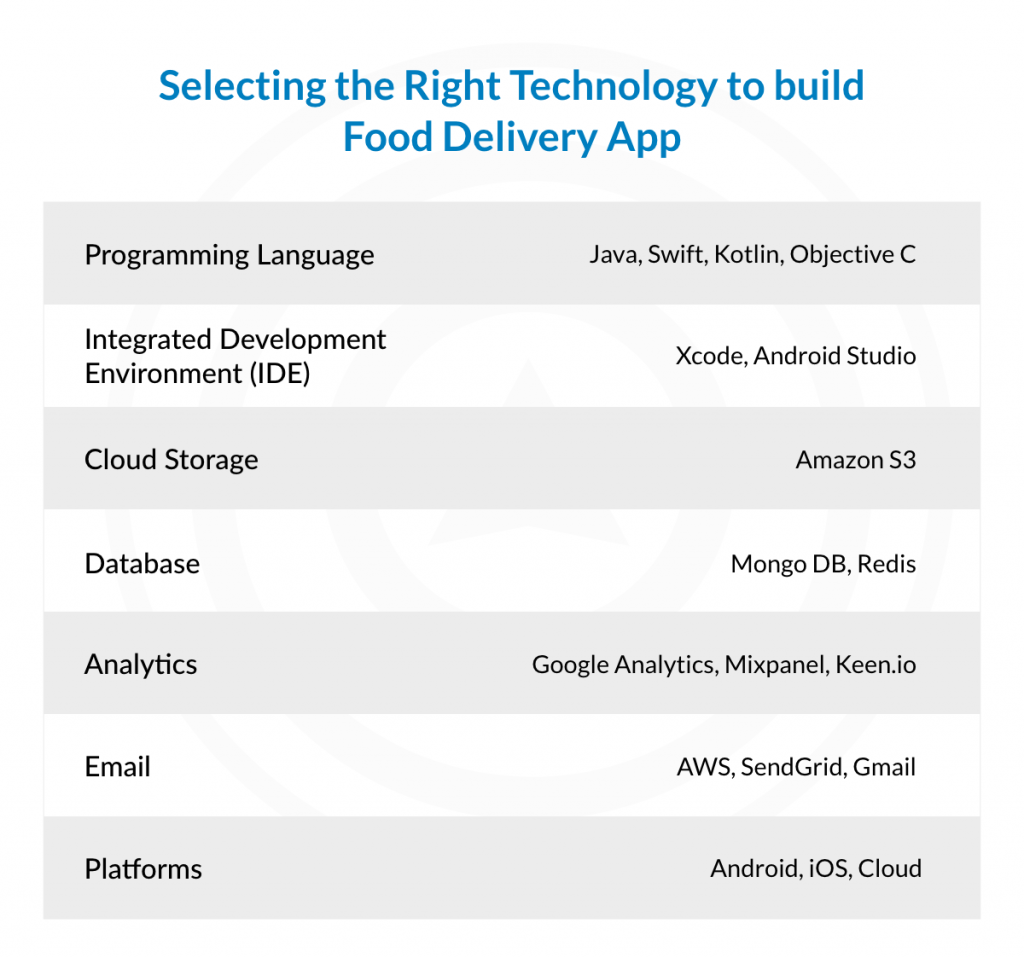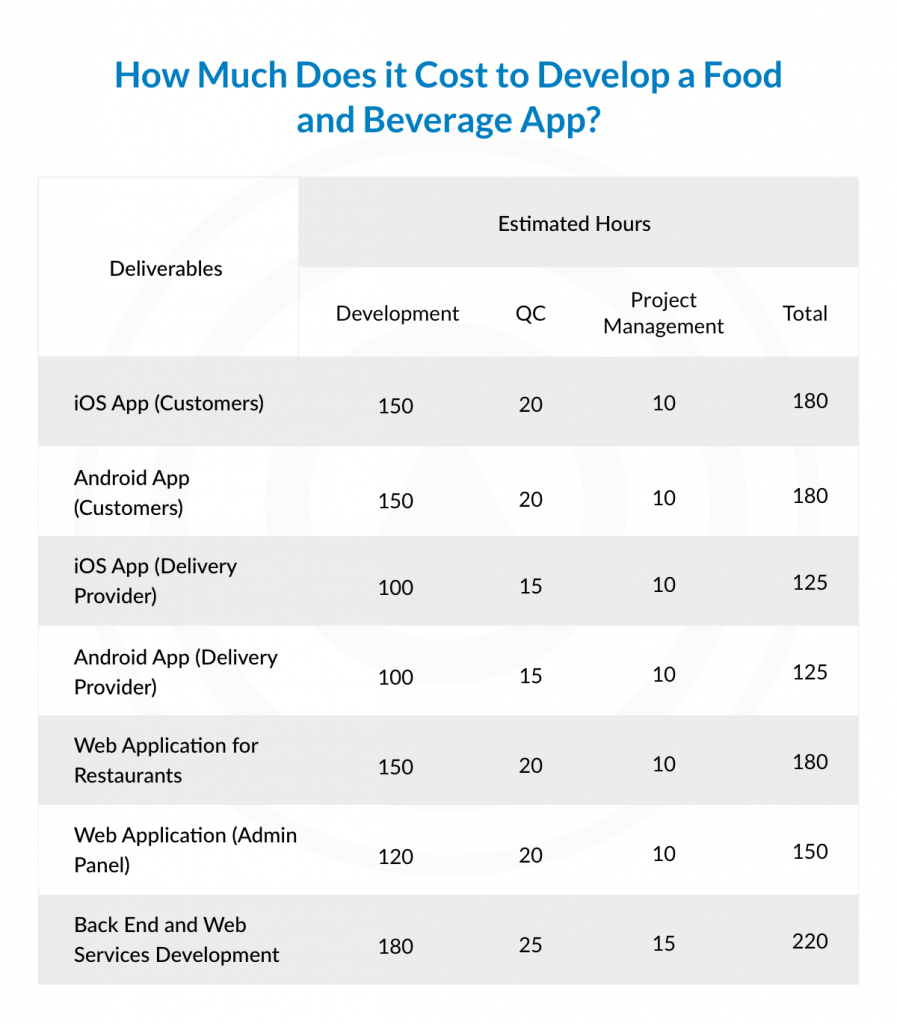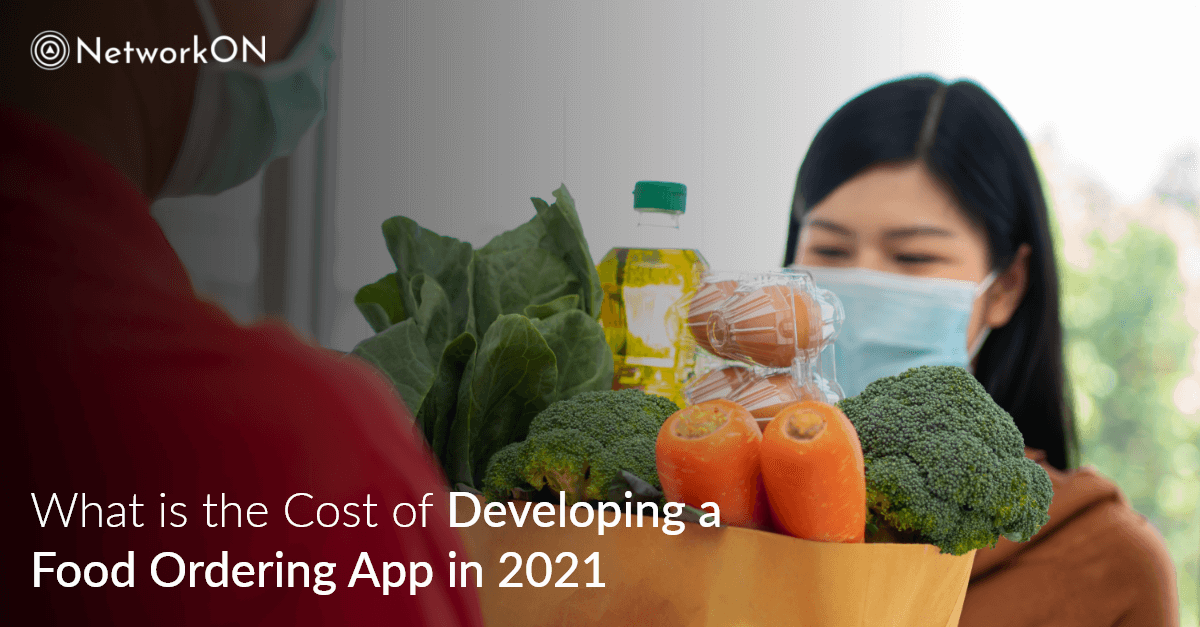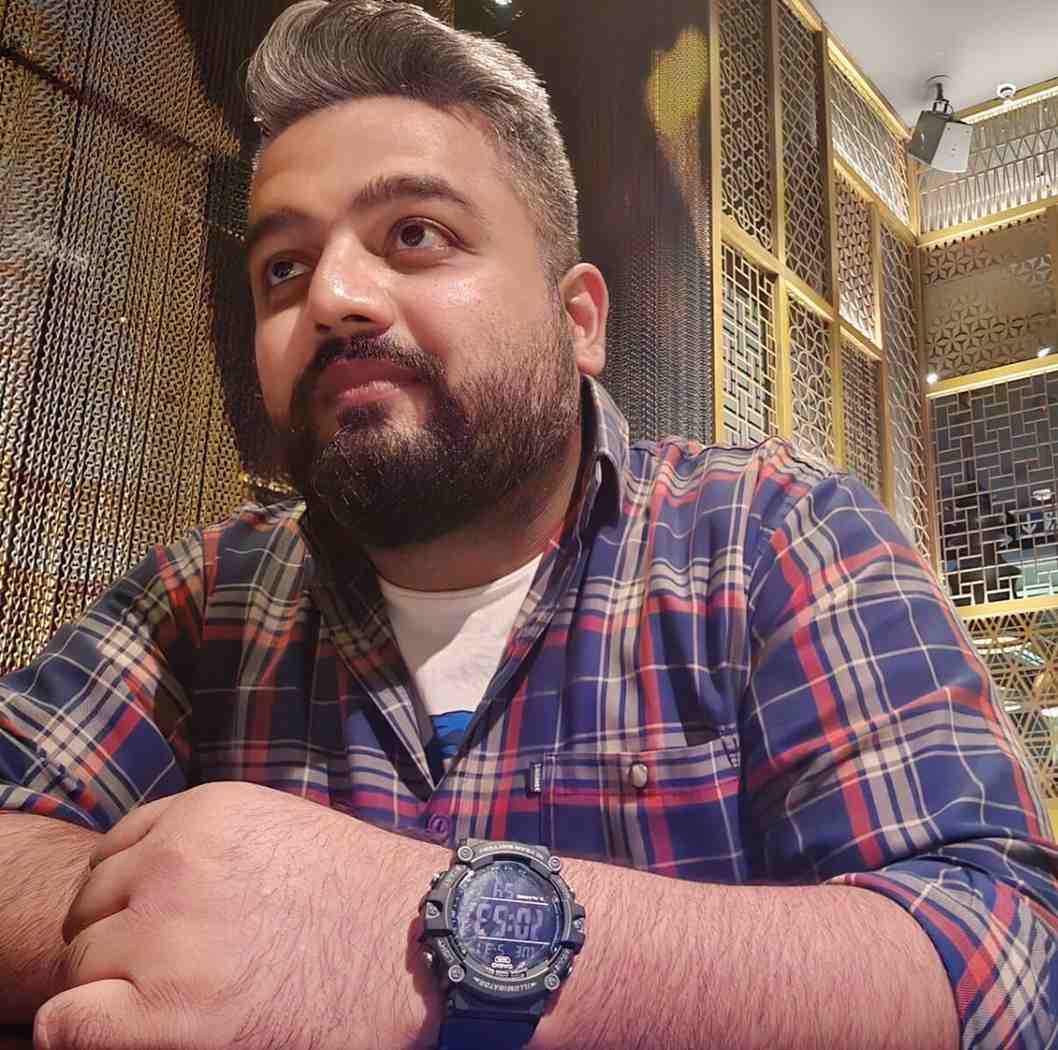Table of Contents
Amidst the COVID-19 pandemic, the food delivery market has surpassed $25 billion in the US alone. With online food deliveries becoming a routine, food delivery platforms across the globe are engaged in a battle to gain a larger market share.
The rise of online food apps like DoorDash, Uber Eats, Just Eat, and Swiggy has also transformed traditional restaurant dine-ins into food delivery hubs. This is leading to a lot of local restaurants and micro food brands wanting to have their own food delivery app. Especially if one has a customer base then why pay the food delivery companies like Uber Eats a heft 20-25% of the bill amount in addition to the delivery fees.
For budding entrepreneurs or established food related businesses aspiring to get into the food delivery business, the fundamental question is–what is the overall cost of developing a food and beverage app?
Since there are no precise estimates, agencies are charging different rates depending on a number of geological, technical, and financial factors. We have prepared this blog to help you get all the answers to your how, why, and when for developing a food delivery app. So let’s dive into it!
Embracing Contactless Delivery Options
The way we receive our favorite dishes has made a seismic shift towards safety and convenience with the rise of contactless delivery. This change, primarily driven by the COVID-19 pandemic, has redefined the food delivery landscape. Enjoying your meal without direct interaction with the delivery personnel isn’t just an innovation; it’s now a staple feature in the food delivery app experience.
The Rise of Contactless Delivery During COVID-19
When COVID-19 altered our reality, food delivery apps quickly responded by implementing contactless delivery options. This initiative reflected an immediate need to minimize human contact, reduce the risk of virus transmission, and keep both customers and delivery staff safe while enjoying a wide range of culinary delights right at home.
How Food Delivery Services Have Adapted to Prioritize Safety
Adapting to a new normal, food delivery services rolled out innovative features to ensure safety is the top priority. Here’s how:
- App developers introduced in-app features that allow customers to choose contactless delivery at checkout.
- Special instructions and pictures can now guide where meals should be dropped off for additional convenience.
- Real-time tracking and automated alerts inform customers when their food arrives; face-to-face confirmation is unnecessary.
- Delivery personnel are provided safety training and gear, including masks and sanitizers, to ensure hygienic handling and delivery.
Through these measures, food delivery apps have proven to evolve swiftly to address consumer needs, underscoring the importance of flexibility and responsiveness in the ever-changing tech landscape.
What is a Food Delivery App?
A Food delivery app is a mobile interface with which clients can place an order from restaurants available in their location.
Since most people have little time to go to restaurants, food delivery apps act as a bridge between restaurant owners and customers, enabling seamless food ordering and delivery right at the doorsteps.
How does a Food Delivery App work?
An online food delivery platform is not just a single app but four different apps that work in integration to ensure a seamless food delivery process.
Customer App
The customer app is installed on the smartphone of your customers. The app needs to be user-friendly with important features to check out all the available restaurants and discount offers.
- Customers sign in and register their profile with a valid email address
- Users can browse the food menu of each available restaurant
- Upon selecting a choice of food, the user can place an order
- By making the final payment, the order is confirmed
- Users can track the delivery time and location of the drivers in realtime
- Upon receiving the order, users can review the food and service
Restaurant App
The restaurant owner also uses a web application that lets them manage delivery orders.
- The restaurant lists the food menu with prices. An update the menu, change pricing and run special promotions.
- They receive an order and confirm it on the basis of availability
- The restaurant assigns the staff to prepare the specific order after confirmation
- While preparing the food item, the restaurant owner can also check the nearby delivery agents and assign one to begin food delivery
- Once a delivery agent is selected, real-time tracking helps to project an ETA
Delivery Agent App
The delivery agent manages the pick-up and drop-off using this app.
- The agent registers a profile on the app by entering personal details and driving license number
- Once the information is verified, the delivery agent can receive and accept orders based on their convenience
- Once an order is accepted, the delivery agent receives all the delivery task details will real-time navigation and route suggestions
- Once the food is delivered, the delivery agent can mark the order as complete on the app
Admin Panel
The admin panel allows seamless integration and smooth functioning between the restaurant, delivery agents, and the end customer.
The basic features and functionalities of an admin panel are:
- Order Booking and Fulfilment Management
- Vehicle and Delivery Agent Detail Management
- Location and Route Tracking of All Agents
- Manage Ratings and Reviews
- Real-time Messaging and Customer Support
- Run Promotions and Discounts
Selecting the Right Technology to build Food Delivery App
Choosing the right technology is important to create a successful app. For an on-demand delivery app, here is the tech stack you will require to go forward:

Optimizing User Experience and Interface Design in Food Delivery Apps
When hunger strikes, the last thing users want is to wrestle with a clunky app. Optimizing user experience (UX) and interface design is the secret to any food delivery app’s success. A smooth, intuitive interface delights customers and keeps them coming back for seconds. Let’s dive into what it takes to create an app interface that’s as mouth-watering as the food it delivers.
Best Practices for Designing a User-Friendly App Interface
- Clarity: Keep the design simple. Use clear icons and labels to ensure that navigation is easy as pie.
- Responsiveness: An app should load faster than a microwave meal. Each interaction should feel snappy and satisfying.
- Accessibility: Cater to all users by incorporating features like text size adjustments and voice commands.
- Consistency: Maintain a consistent layout and color scheme throughout the app to avoid confusing users.
- Feedback: Provide immediate feedback through notifications and animations so users know their orders are being cooked.
The Impact of UX on Customer Satisfaction
Ever ditched a restaurant because the service was slow? The same goes for food delivery apps. Users crave quick, effortless service; superior UX can significantly boost customer satisfaction. An app with a well-thought-out design helps users make decisions smoothly and encourages loyalty by offering a seamless journey from menu browsing to order confirmation. So, just like in the kitchen, the ingredients for creating a perfect app experience include a pinch of innovation, a dash of simplicity, and heaps of attention to detail.
Seamless Transactions With Diverse Payment Method Integration
One can never underestimate the power of convenience in the fast-paced world of food delivery apps. The last thing hungry users want is a snag at the checkout due to limited payment options. Let’s slice into the necessity of offering multiple payment options and how this choice can transform the user experience and checkout process.
The Necessity of Offering Multiple Payment Options
Today’s foodies don’t just crave delicious meals at their doorstep; they demand various payment options to match their lifestyle. Whether it’s the cutting-edge tech enthusiast who prefers the newest digital wallet or the careful consumer who sticks to credit cards, accommodating every diner’s payment preference is not just nice—it’s crucial.
How Integration Affects the User’s Checkout Experience
We’re in the era of personalized experiences, and checkout processes are no exception. An app that swiftly adapts to the user’s favorite payment method doesn’t just expedite the checkout process; it endears them to the service. Imagine the satisfaction of a seamless transaction without having to scrounge for a physical wallet—pure bliss!
Popular Payment Platforms and Security Concerns
With the buffet of payment platforms like PayPal, Apple Pay, Google Pay, and various credit and debit cards, there’s much to chew on. However, with great variety comes great responsibility—especially regarding security. Strong encryption and rigorous data protection measures are not just features; they assure customers that their financial health is protected while they feed their appetites.
- Digital Wallets: Quick and contactless, they cater to the tech-savvy crowd.
- Credit/Debit Cards: The old-school staple still holds strong for widespread acceptance.
- Bank Transfers: Appealing to those who prefer direct transactions from their accounts.
- Cash on Delivery: An evergreen option for those who might be less digitally inclined.
How Much Does it Cost to Develop a Food and Beverage App?
To create an accurate cost of developing food ordering App, parameters like features, functionalities, and platforms have to be considered.
The simple formula of getting a cost estimate is:
Total mobile app development cost = Total development hours x Developer’s hourly rate

With US-based developers, you may have to pay an hourly rate between $50 to $200, depending upon the expertise you require. While European and Asian developers charge anywhere between $20 to $80 an hour.
The NetworkON Advantage
For a food and beverage delivery app development, it’s important to understand your target niche market, challenges you would face, and how would you resolve them.
A successful food delivery app should fit into a customer’s schedule, should be user-friendly, and work seamlessly for restaurant owners.
With NetworkON, you have the power to develop an app that synergizes with your capabilities and helps you achieve business growth and success. Our food delivery app development packages start from just $4k, while extra customizations and integrations are available at different rates. To learn more about NetworkON contact our experts here or mail us at info@networkon.io.
Frequently Asked Questions:
Q. What factors contribute to the overall cost of developing a food delivery app in 2024?
The cost is influenced by geographical, technical, and financial factors. Rates vary among agencies, making precise estimates challenging.
Q. How has the COVID-19 pandemic impacted the food delivery market, and why are more businesses interested in developing their food delivery apps?
The pandemic has led to a significant surge in the food delivery market, exceeding $25 billion in the US alone. Local restaurants seek app development to avoid high fees from existing delivery platforms.
Q. What are the key components of a food delivery app, and how do they work together in the delivery process?
A food delivery app comprises customer, restaurant, and delivery agent apps and an admin panel. They collaborate to facilitate seamless order placement, preparation, and delivery.
Q. How can user experience (UX) and interface design impact the success of a food delivery app?
A well-optimized, user-friendly interface enhances customer satisfaction and loyalty, emphasizing the importance of clarity, responsiveness, accessibility, consistency, and immediate feedback.
Q. Why is offering multiple payment options crucial for the success of a food delivery app?
Diverse payment options cater to various user preferences, enhancing the overall customer experience during checkout and fostering user loyalty.
Q. What is the estimated cost of developing a food and beverage app, and what factors should be considered in the calculation?
The cost depends on features, functionalities, and platforms. The formula provided is total development hours multiplied by the developer’s hourly rate, with rates ranging from $20 to $200 per hour based on location and expertise.





Dai Software
This is an informative post. Got a lot of info and details from here. Thank you for sharing this and looking forward to reading more of your post.